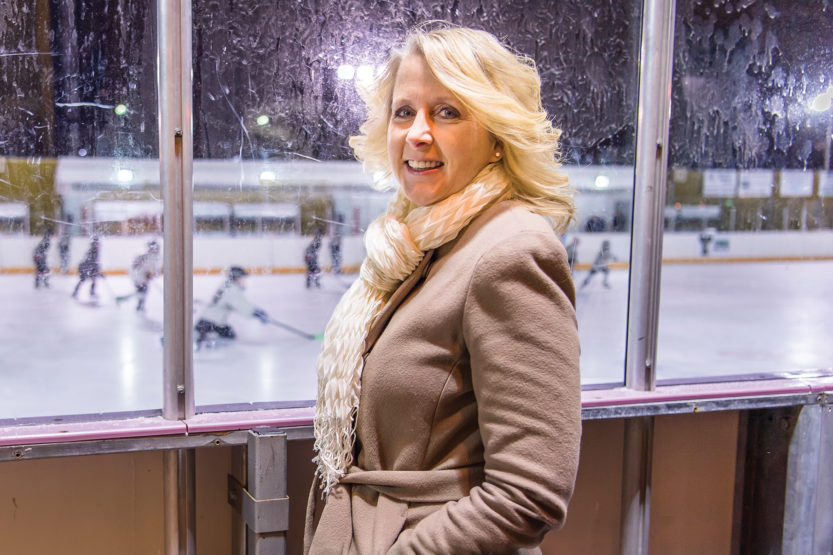Alumni Interview: Elizabeth Pieroth
 “I’m hoping to help make sports safer for millions of athletes,” says Elizabeth Pieroth, ’88 LAS, a board-certified neuropsychologist and associate director of the sports concussion program at NorthShore University Health System. (Image by Scott Thompson)
“I’m hoping to help make sports safer for millions of athletes,” says Elizabeth Pieroth, ’88 LAS, a board-certified neuropsychologist and associate director of the sports concussion program at NorthShore University Health System. (Image by Scott Thompson) As a mom as well as a concussion specialist working with the Chicago Bears, Blackhawks, White Sox, Fire and National Women’s Soccer League, I’m often asked if I would let my own son play contact sports. The answer is ‘yes.’ In fact, that’s just what I do. My 13-year-old plays football and both of my sons play hockey. That doesn’t mean I don’t worry about the risk of them playing a contact sport. Of course I do! I am committed to making sure my sons’ coaches and sport leagues, and all coaches and leagues, follow the rules and teach proper technique. It’s important that everyone involved in youth sports is focused on safety.
We’ve made great strides in limiting the risks in recent years. But there is certainly more work to do, and we’ll never eliminate the risk entirely. However, in light of the obesity problem and numerous related health complications our children are facing these days, we need to keep our kids safe but active and engaged in the sports they love.
It’s amazing how much has changed since I worked with my first concussed professional athlete. I had just completed a residency in the brain injury unit at the Schwab Rehabilitation Hospital in Chicago. It was during my post-doctoral fellowship at Detroit’s Henry Ford Hospital, working with Dr. Mark Lovell, a leading concussion researcher and clinician. That was in 1997, the first year of the National Hockey League’s formal concussion program. We tested Detroit Red Wings players before the season and then after they suffered a concussion. In those days, people were much less concerned about concussions. They minimized the problem and simply said you “got your bell rung” or you “got dinged.” I’ve since devoted my career to educating athletes, parents and the public on how best to detect and treat concussions.
That’s the best way to stay on the field, the court or the ice, and to stay healthy in the long term.
Today, the pro players and coaches I work with are far more cooperative. They know what the symptoms of a concussion are and they know it’s in their best interest to follow current medical guidelines. That’s the best way to stay on the field, the court or the ice, and to stay healthy in the long term.
The degree of knowledge in the public varies quite a bit. In this age of Google and Wikipedia, I spend a lot of time correcting misconceptions that people find online. Misconceptions like these:
Concussions knock you unconscious. No, only about 10 percent of concussions result in a loss of consciousness.
A headache means you’ve had a concussion. Again, not always. A headache is the most common symptom of a concussion, but there are many other causes of headaches. Health-care providers need to take the time to make the right diagnosis.
If you’re concussed, you need complete rest. This common idea is not supported by science. Reduced activity is recommended for the first one to three days. After that, the next step is a gradual return to activity as tolerated. Our prime concern needs to be symptom management and not rest alone.
A better helmet can prevent concussions. Helmets were designed to prevent skull fractures, but a concussion occurs when the brain moves rapidly inside the skull. New technology in helmets may do a better job of dispersing energy away from the head, but helmets can’t prevent concussions. However, research has shown that the fit of a helmet can make a: A properly fitted helmet offers a greater degree of protection than does a poorly fitted one.
We’ve come a long way since 1997. There’s far more awareness than there used to be. An important next step will be learning more about biomarkers, such as substances in the blood that can tell us if you’ve just had a concussion or if you’ve recovered from a concussion.
I feel lucky to work in such a fascinating field in such a great city. How could a person grow up around Chicago and not love sports?
Now I’m hoping to help make sports safer for millions of athletes and teams including the Bears, Blackhawks, White Sox, Fire and the Illini of the future.

